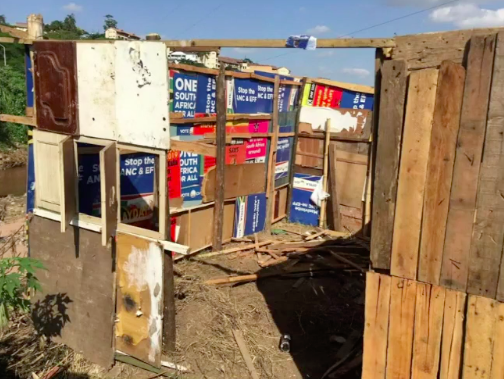Homes in high-risk flood zones are the only affordable option for Durban’s poorest residents.

April’s downpour delivered months worth of rain in a 48-hour period, killing over 450 people and displacing 40,000 more. Photo © Catherine Sutherland.
Laura Gersony, Circle of Blue — April 25, 2022
The rain in Durban was just starting to ease when Catherine Sutherland, an urban geographer at the University of Kwazulu-Natal, decided to return home. Sutherland had been helping to evacuate Quarry Road West, a slum on the banks of the Palmiet River. It was then that she saw a scene that, two weeks later, still haunts her: a family with three young children, wide-eyed and clad in matching bedclothes, fleeing their home for safer ground.
“They were all ready for bed: all cozy, dressed up with their little slippers and fleecy pajamas with little flowers on them,” she said.
The sight was a heart-wrenching but not unexpected sign of a crisis that Sutherland has been studying for years. A massive housing backlog in one of South Africa’s largest cities has created a sprawling slumscape on its periphery: a makeshift metropolis of 440,000 flimsy shacks that house a quarter of the metro population. The family was one of thousands that live precariously in Durban’s floodplains.
The rains that began on April 8 marked one of the worst natural disasters in South Africa’s history. The downpour delivered months worth of rain in a 48-hour period, killing over 450 people and displacing 40,000 more. Unlike previous floods in 2017 and 2019, this storm spared no parts of the city, triggering mudslides in areas rich and poor.
The destruction was concentrated in the slums. In Quarry Road West, the deluge sent three-ton shipping containers, which the community uses as makeshift sanitation facilities, floating down the Palmiet like paper boats. In total, over 4,000 homes were destroyed.
In a city unaffordable for up to one-quarter of its residents, vulnerability to natural hazards is no coincidence: these threats are precisely what make the space affordable for the people who live there. Sutherland’s work has shown that Quarry Road West has expanded after floods and fires, as residents seize the opportunity to build new houses and rent them to new tenants. Globally, a growing share of the population lives in flood zones.
“They know about the risks. They understand, and they’re scared of the flooding. But they’re trading it off because of the locational benefits of being in that space,” Sutherland said. “People are trying to find a place in the city where they can live affordably, and can get access to employment.”
The boom-and-bust cycle pushes the limits of what the land can allow. Open areas that usually serve as a buffer during storms have disappeared. Panicking residents of the settlement messaged Sutherland on WhatsApp on the night of the floods: Quarry Road West was cornered. “People were saying to me, ‘We don’t know where to go. It’s washed away a huge section of the settlement.’”
The roots of the housing crisis extend back decades, when post-apartheid land reforms failed to spur economic development in rural South Africa, concentrating economic opportunity in its cities. The state’s promises of public housing have lapsed into an ever-widening housing backlog.
The gaps left by the state have often been filled by residents themselves. Sutherland’s work documents how residents of the slums rebuild quickly after disasters, spontaneously forming self-governing structures to distribute resources. This spirit of collaboration surfaced, she said, even during the worst of the flooding.
“People formed a human chain. They were pulling each other through this water, going back to help each other, and shouting warnings to each other,” Sutherland said. “Our city is under so much strain — but what holds it together is the social capital of ordinary people. It’s happened over and over again in our city. It’s probably our greatest strength.”

Campaign signs from South Africa’s 2019 elections patch up a damaged home in one of Durban’s many informal settlements. Photo © Catherine Sutherland.
Laura Gersony covers water policy, infrastructure, and energy for Circle of Blue. She also writes FRESH, Circle of Blue’s biweekly digest of Great Lakes policy news, and HotSpots H2O, a monthly column about the regions and populations most at-risk for water-related hazards and conflict. She is an Environmental Studies and Political Science major at the University of Chicago and an avid Lake Michigan swimmer.




